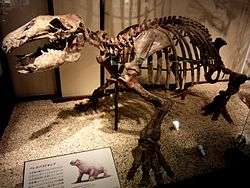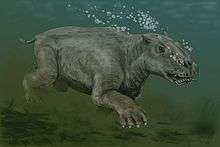Paleoparadoxia
| Paleoparadoxia Temporal range: Miocene | |
|---|---|
 | |
| P. tabatai | |
| Scientific classification | |
| Kingdom: | Animalia |
| Phylum: | Chordata |
| Class: | Mammalia |
| Order: | Desmostylia |
| Family: | Paleoparadoxiidae Reinhart 1959[1] |
| Genus: | Paleoparadoxia Reinhart 1959[2] |
| Type species | |
| Paleoparadoxia tabatai | |
| Species | |
|
P. media Inuzuka 2005[3] | |
Paleoparadoxia ("ancient paradox") is a genus of large, herbivorous aquatic mammals that inhabited the northern Pacific coastal region during the Miocene epoch (20 to 10 million years ago). It ranged from the waters of Japan (Tsuyama and Yanagawa), to Alaska in the north, and down to Baja California, Mexico. Paleoparadoxia was about 2.2 m (7 ft 3 in) long.[5]
Description

Paleoparadoxia is thought to have fed primarily on seaweeds and sea grasses. The jaws and the angle of the teeth resemble a backhoe bucket. Its bulky body was well adapted for swimming and underwater foraging, but not for extended deep-sea living or deep diving. Originally interpreted as amphibious, Paleoparadoxia is now thought to have been a fully marine mammal like their living relatives, the sirenians, spending most of their lives walking across the sea bottom like marine hippos.[6]
Tokunaga 1939 named the genus Cornwallius but Reinhart 1959 synonymized it as a species of Paleoparadoxia.[7]
Notes
| Wikimedia Commons has media related to Paleoparadoxia. |
- ↑ Paleoparadoxiidae in the Paleobiology Database. Retrieved March 2013.
- ↑ Paleoparadoxia in the Paleobiology Database. Retrieved March 2013.
- ↑ Paleoparadoxia media in the Paleobiology Database. Retrieved March 2013.
- ↑ "Yoshiwara, Shigeyasu". Sirenia.org. Retrieved March 2013. Check date values in:
|access-date=(help) - ↑ Kemp 2005, p. 254
- ↑ Hayashi et al. 2013
- ↑ "OPINION 2232 (Case 3384) Cornwallius tabatai Tokunaga, 1939 (currently Paleoparadoxia tabatai; Mammalia, Desmostylia): proposed designation of a neotype not accepted". ICZN. Retrieved March 2013. Check date values in:
|access-date=(help)
References
- Clark, J. M. (1991). "A new early Miocene species of Paleoparadoxia (Mammalia: Desmostylia) from California". Journal of Vertebrate Paleontology. 11 (4): 490–508. doi:10.1080/02724634.1991.10011417. OCLC 4908959659.
- Domning, D. P.; Barnes, L. G. (2007). "A new name for the 'Stanford Skeleton' of Paleoparadoxia (Mammalia, Desmostylia)". Journal of Vertebrate Paleontology. 27 (3): 748–751. doi:10.1671/0272-4634(2007)27[748:annfts]2.0.co;2. OCLC 4630515072.
- Hayashi, Shoji; Houssaye, Alexandra; Nakajima, Yasuhisa; Chiba, Kentaro; Ando, Tatsuro; Sawamura, Hiroshi; Inuzuka, Norihisa; Kaneko, Naotomo; Osaki, Tomohiro (2013). "Bone Inner Structure Suggests Increasing Aquatic Adaptations in Desmostylia (Mammalia, Afrotheria)". PLOS ONE. 8 (4): e59146. doi:10.1371/journal.pone.0059146. PMC 3615000
 . PMID 23565143. Cite uses deprecated parameter
. PMID 23565143. Cite uses deprecated parameter |coauthors=(help) - Inuzuka, Norihisa (2005). "The Stanford Skeleton of Paleoparadoxia (Mammalia: Desmostylia)". Bulletin of the Ashoro Museum of Paleontology. 3: 3–110.
- Kemp, Tom S. (2005). The Origin and Evolution of Mammals. Oxford University Press. ISBN 0198507615. OCLC 56652579.
- Reinhart, Roy Herbert (1959). "A review of the Sirenia and Desmostylia". University of California Publications in Geological Sciences. 36 (1): 1–146. OCLC 3474601.
- Tokunaga, Shigeyasu (1939). "A new fossil mammal belonging to the Desmostylidae". Jubilee publication commemorating Prof. H. Yabe, M.I.A. sixtieth birthday. 1. Sendai (Japan): Tohoku Imperial University, Inst. Geol. Pal. pp. 289–299. Retrieved March 2013. Check date values in:
|access-date=(help)